
Trade potential between India and Pakistan remains hostage to the uncertain relations between the two countries

Trade between Pakistan and India has seen many ups and downs. After partition, interestingly, Indo-Pak trade ties were good. The 1965 war came as a major setback. Later on, however, trade did pick up pace but its volume has never even come close to the actual trade potential that exists.
The two countries have been demanding favours from each other but there has not been any major breakthrough. India has failed to win the Most Favoured Nation (MFN) status from Pakistan, and Pakistan has not been successful in overcoming the non-tariff barriers imposed on the products it exports to India. To add to this, a deadlock exists on the issue of granting transit routes to each other.
Nevertheless, the opening of a land route via Attari in 2005 for trade of a limited number of commodities was taken as a major sign of progress. An Integrated Check Post (ICP) at this point was opened in April 2012 and quality warehouses, weighing scales, quarantine facilities, etc, were set up and faster movement of goods was made possible. The situation can improve further if Pakistan completes work on a similar facility on its side of the border.
Pradeep S Mehta, Secretary General, CUTS International -- a Jaipur based consumer group in India -- thinks Indo-Pak trade has not been affected much by turbulence in the countries’ diplomatic relationship and shares figures to support his claims. "In FY 2015-16, Indo-Pak bilateral trade has registered 8 per cent growth from the year 2014-15. It was US$2.5 billion in 2015-16 as against US$2.3 billion in 2014-15. In the last five years, i.e., between 2011-12 and 2015-16, the peak point wherein mutual trade remained the highest- around US $ 2.7 billion is in the FY 2013-14," he tells TNS.
Mehta points out that, for the last five years, the bilateral trade between the two neighbours has been around US $ 2.4 billion on an average. "This figure has, over the years, insulated itself from any diplomatic rip-off and political imbroglio over Kashmir -- meaning trade, through the notified land and sea routes, adjusts to the shocks to achieve the US$ 2.4 billon benchmark."
Recently, the trade route linking Poonch in India to Rawalakot in Pakistan was closed after protests erupted in Muzaffarabad and other parts of Azad Jammu and Kashmir. Trade on this route that started in 2008 has often remained suspended due to similar situation arising from time to time.
But, does this suspension of trade across the Line of Control (LoC) affect the overall figure? Aftab Ahmed Vohra, Chairman of Lahore Chamber of Commerce and Industry’s committee on Indo-Pak trade replies in the negative. He says this trade cannot be called formal trade as the Line of Control (LOC) is not a proper border and mostly goods are transported across the border without paying duties. "It is also very difficult to sell these goods in Pakistani areas outside Kashmir," he adds.
He tells TNS that informal trade through third country like Dubai has been more than twice the formal one but the good thing is that it is on the decrease. "The reason simply is that Pakistan has introduced a list of 1,209 Indian products, excluding which everything else can be imported from India." So, he says, it will no more be feasible to use a route that is a lot longer, pay additional costs, wait for longer periods for delivery and face the risk of getting caught.
According to a CUTS report, "India’s major export to Pakistan includes fresh fruits and vegetables, biscuits, fresh meat, cotton bales, household goods and polypropylene granules. On the other hand, India’s major imports from Pakistan include gypsum rock, clinker, gypsum powder, salt, soda ash, dry fruits, caustic flake, dry dates, herbs, hydrogen peroxide, limestone, calcium, sugar and household goods."
Read also: After the speech
Mehta believes that this list can be further expanded and volumes can skyrocket if these countries take the matter seriously. He says it is tautological to say that India and Pakistan are yet to realise their untapped trade potential. "To do so, both countries need to resume and sustain their dialogue on economic cooperation. In this regard, state/provincial governments and business chambers have to take the lead and advocate with the respective central/federal government. Not only will this generate new production and trading opportunities but there will also be new revenue-generation even at the sub-national level."
On the other hand, Vohra thinks the Indo-Pak trade is in fact trade between the Pakistani Punjab and the Indian Punjab and the other parts of the two countries rarely indulge in mutual trade. He says he has been travelling to India for business for a good 20 years but has not seen Pakistanis trying to tap into markets beyond Delhi. "Kolkata, Hyderabad Deccan, etc, are not at all on their map."
This year, he says, Pakistan imported cotton in huge quantities from India (as Indian cotton crop was destroyed due to floods and pest attacks); but India chose to look to other global markets for purchase of soybean meal. The reason was that the cost of importing from these destinations was far less than what it would have cost to import from India.
According to him, "For the shipment to get through now, a quarantine certificate and the permission to bring in a certain quantity of vegetables will be required. This can be a step to support Pakistani farmers or a reaction to the Indian aggression on different fronts."